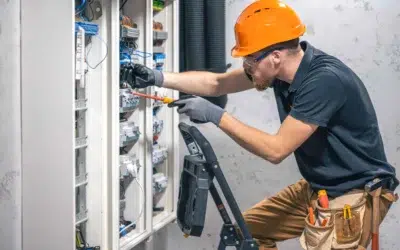It’s easy to take elevators for granted until the day one stops between floors with you inside. Whether you’re alone or with strangers, the moment the hum goes silent and the lights flicker, a wave of uncertainty sets in.
Suppose you’ve never been trapped in an elevator; good. But if it ever happens or has already, you’ll want to know more about the elevator emergency tips beyond the surface level.
That is why we’re sharing the dos and don’ts in elevator emergencies.
This guide will help you learn how to handle a situation that feels out of your control and think rationally when everything seems uncertain. Keep reading to learn more.
In This Blog
- What You Should Do (The Do’s)?
- What You Should NOT Do (The Don’ts)
What You Should Do (The Do’s)?
Getting stuck in an elevator is scary. But responding to it appropriately instead of reacting to the situation will make your way out of the elevator much easier. Listed below are a few things you must do when your elevator stops in the middle.
1. Control the One Thing You Can: Your Mind
It may sound obvious, but it’s the first and most powerful thing you can do.
When the elevator comes to an unexpected stop, your body may shift into panic mode—sweaty palms, racing heart, shallow breathing. But giving in to fear only clouds your judgment.
Keep going to understand the dos and don’ts in elevator emergencies in depth.
Here’s what staying calm can do for you:
- Helps conserve energy.
- Allows you to think logically and.
- Encourage you to make good decisions.
- Provide support for your fellow passengers.
- Take care of children and elderly people.
Tip: Take slow, deep breaths. If you’re alone, speak to yourself gently as if reassuring a friend.
2. Use the Emergency Button
Elevators are equipped with an emergency call button. They are often marked in red or with a bell icon. It directly connects you to building management, a 24/7 call center, or emergency services, depending on the system.
What happens when you press it?
- An operator is notified of your exact elevator location.
- You can speak with someone through an intercom.
- It initiates official elevator rescue protocols.
Where to find it: Usually near the floor selection panel. If it’s a touchscreen or digital panel, there will still be a tactile emergency option available.
3. Call for Help Using Your Phone (If You Have Signal)
Elevators are known for blocking signals. But that should not stop you from checking if you’ve got any signals. Keep trying to connect for help.
These elevator emergency tips are what you must do if you’ve got bars:
- Call the building’s security number near the control panel
- If unavailable, call local emergency services and provide:
- The building’s address
- Your floor (based on where the elevator stopped)
- Any identifying numbers inside the lift
Quick tip: If you regularly use a particular building, save its security number in your phone. It can save time in moments like this.
Or take a photo of the certificate plate inside the elevator that has maintenance company info, elevator number, and capacity, which can be useful during elevator emergencies.
4. Let Others Know You’re Inside
Not all elevator alarms are loud or noticeable, especially in quiet buildings or during off-hours. It’s okay to gently knock on the doors or call out for help. If you hear footsteps or voices outside, speak up. A calm, firm voice calling, “Excuse me, I’m stuck in the elevator,” is enough.
Why this matters:
- Bystanders can alert security or call 911 on your behalf.
- It reassures you that someone knows you’re in there.
- In case of power failure, your voice or knock may be the only signal available.
Note: Don’t shout repeatedly. It may cause unnecessary distress to others and drain your energy.
5. Wait Patiently and Follow Instructions
Once you’ve made contact, the best thing you can do is wait, even if you feel like you’re doing nothing to escape.
Why waiting is part of the solution:
- Staying still makes it easier for rescuers to predict your location and movements.
- Elevator rescues are handled by trained professionals with clear protocols.
- It might take 15–60 minutes, depending on the issue and time of day.
- Forcing open doors or climbing out only complicates their job.
Common Elevator Response Times (Approximate)
| Type of Building | Average Response Time |
| Residential (urban) | 15–30 minutes |
| Commercial high-rise | 20–40 minutes |
| Off-peak / weekends | 30–60 minutes |
Do This While Waiting:
- Stay seated if you’re lightheaded or anxious
- Check on others in the lift if you’re not alone
- Avoid pacing or pressing buttons repeatedly
What You Should NOT Do (The Don’ts)
When you’re stuck in an elevator, you’ll do everything to get out of that thing. But, doing certain things will complicate the situation even more and may result in the delay of help. In this guide about dos and don’ts in elevator emergencies, we’re going to learn about such things next:
1. Don’t Try to Force the Doors
Elevator doors may appear to move slightly when tugged, giving the illusion of progress. But forcing them can:
- Trigger additional faults in the system
- Damage sensors, delaying repairs
- May result in injury or legal issues
- Put you at risk of getting stuck halfway
The safest place to be is inside the elevator car. Because tampering with its design breaks the safety net it’s built on.
2. Don’t Attempt to Climb Out Even If You See a Gap
Climbing out of a stuck elevator is one of the most dangerous things you can do. Elevator doors are designed to be locked when the car isn’t at a designated floor. The car may begin moving again without warning, and in many tragic cases, this has led to fatal injuries.
Here’s what makes this move risky:
- You don’t know if the elevator has lost power or just paused.
- The shaft is a moving, mechanical space, not a stable exit.
- Creates even more trouble for the technicians to rescue you.
Remember: Stay put unless a trained professional instructs you to exit and assists you with it.
3. Don’t Panic or Shout Uncontrollably
We understand you’re afraid. But it is not the time to panic and scream. What’s more important is to take rational decisions that preserve your energy and safety and do not unsettle others in the car.
- Focus on rhythmic breathing.
- Use logical steps to reassure yourself.
- Talk calmly to others if you’re with someone.
4. Don’t Ignore the Alarm or Emergency Features
Every unit of elevators is built with systems that can aid anyone during an unexpected situation. It comes equipped with battery backup, two-way communications, and many more features. It’s surprising how many people overlook the tools available in a modern lift:
- Emergency intercoms
- Visible signs or QR codes
- Maintenance labels with helpline numbers
- Digital displays showing car ID and maintenance info
Use these settings available in the elevator for quicker help and rescue.
5. Don’t Damage the Controls in Frustration
Do you think pressing the button and hitting the panel or pulling the levers can make the elevators work magically? The answer is a clear NO.
What can it lead to?
- Short-circuiting the control board.
- Leave permanent damage for the next users.
- Disabling the very features meant to alert rescue teams.
- Causing delays in both the rescue and the elevator’s return to service.
So be careful when you use the emergency support system during an adverse situation, even if you’re scared, angry, and frustrated.
Key Points Covered
- Elevator accidents and emergencies can be dealt with easily if you have the right education.
- Understand the emergency control system in the elevators and learn how and when to use it.
- Instead of panicking and reacting, try to calm yourself and think through every action before doing it.
- Keeping the security number will help you reach out for help easily.
- Protect yourself and your companions while you’re stuck in it.
- If you’re an elevator owner, provide regular maintenance for your elevators to keep them working properly.
Elevators have become a part of our lives, and we can’t completely avoid using them even if we’re scared of getting stuck inside them. But you can find a way through it by understanding the dos and don’ts in elevator emergencies.
However much worse an elevator situation you’re in, staying calm and following the elevator emergency tips we’ve discussed here will help you get out of it safe and sound.
Yorklift is the best elevator company in Dubai known for providing regular maintenance and safety services. With 20+ years of industry expertise, we’re a one-stop shop for everything related to elevators.





